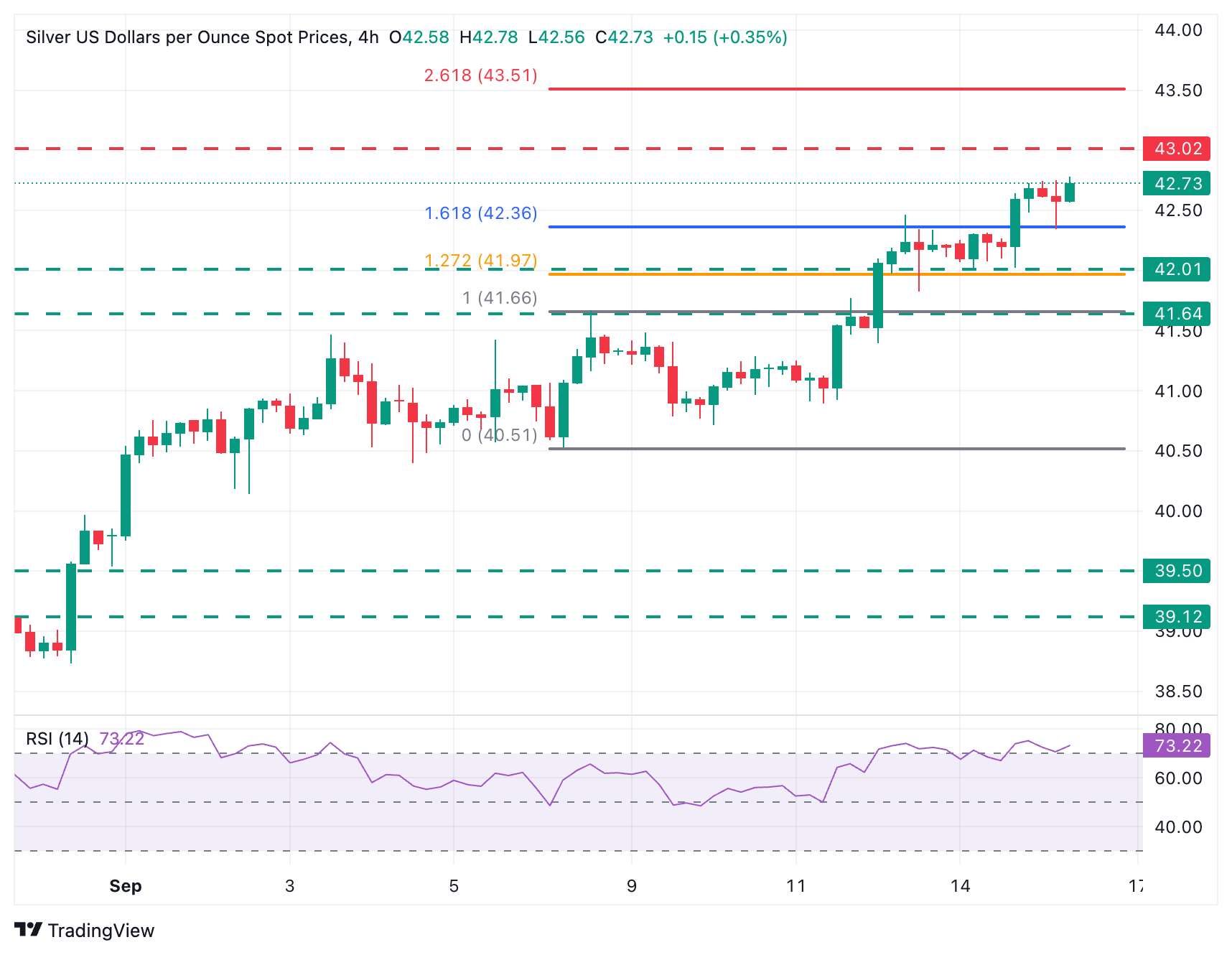Silver Price Forecast: XAG/USD is pushing against $42.75 highs amid US Dollar’s weakness
- Silver is testing long-term highs at $42.75 favoured by broad-based Dollar weakness.
- Market expectations that the Fed will hint at a series of rate cuts are hammering the US Dollar.
- XAG/USD is reaching oversold levels, but downside attempts keep finding buyers.
Silver’s (XAG/USD) is trying to break all-time highs at $42.75 on Tuesday’s Early European session, favoured by broad-based US Dollar weakness, as the market braces for a “dovish cut” at the end of a two-day Fed monetary policy meeting on Wednesday.
Precious metals have been thriving in recent days with investors pricing in a series of rate cuts by the Federal Reserve in the coming months, starting with a quarter-point cut on Wednesday.
The US Dollar Index, which measures the value of the US dollar against a basket of currencies, is testing two-month lows, just above 97.00, after depreciating nearly 1% from last week’s highs.
Technical analysis: XAG/USD has scope for further appreciation

The technical pìcture is bullish, Momentum indicators show overbought levels on intra-day charts –the 4-hour RSI is above 70, but US Dollar weakness keeps downside attempts limited.
To the upside, above the mentioned $42.75 resistance area, the $43.00 psychological level might hold bulls ahead of the 261.8% retracement of the September 8 rally, at $43.50.
The pair has solid support at a previous resistance in the area of $42.50. Below here, the September 14 and 15 low, at $42.00, and the September 8 high, at $41.65, would come into focus.
Silver FAQs
Silver is a precious metal highly traded among investors. It has been historically used as a store of value and a medium of exchange. Although less popular than Gold, traders may turn to Silver to diversify their investment portfolio, for its intrinsic value or as a potential hedge during high-inflation periods. Investors can buy physical Silver, in coins or in bars, or trade it through vehicles such as Exchange Traded Funds, which track its price on international markets.
Silver prices can move due to a wide range of factors. Geopolitical instability or fears of a deep recession can make Silver price escalate due to its safe-haven status, although to a lesser extent than Gold's. As a yieldless asset, Silver tends to rise with lower interest rates. Its moves also depend on how the US Dollar (USD) behaves as the asset is priced in dollars (XAG/USD). A strong Dollar tends to keep the price of Silver at bay, whereas a weaker Dollar is likely to propel prices up. Other factors such as investment demand, mining supply – Silver is much more abundant than Gold – and recycling rates can also affect prices.
Silver is widely used in industry, particularly in sectors such as electronics or solar energy, as it has one of the highest electric conductivity of all metals – more than Copper and Gold. A surge in demand can increase prices, while a decline tends to lower them. Dynamics in the US, Chinese and Indian economies can also contribute to price swings: for the US and particularly China, their big industrial sectors use Silver in various processes; in India, consumers’ demand for the precious metal for jewellery also plays a key role in setting prices.
Silver prices tend to follow Gold's moves. When Gold prices rise, Silver typically follows suit, as their status as safe-haven assets is similar. The Gold/Silver ratio, which shows the number of ounces of Silver needed to equal the value of one ounce of Gold, may help to determine the relative valuation between both metals. Some investors may consider a high ratio as an indicator that Silver is undervalued, or Gold is overvalued. On the contrary, a low ratio might suggest that Gold is undervalued relative to Silver.

